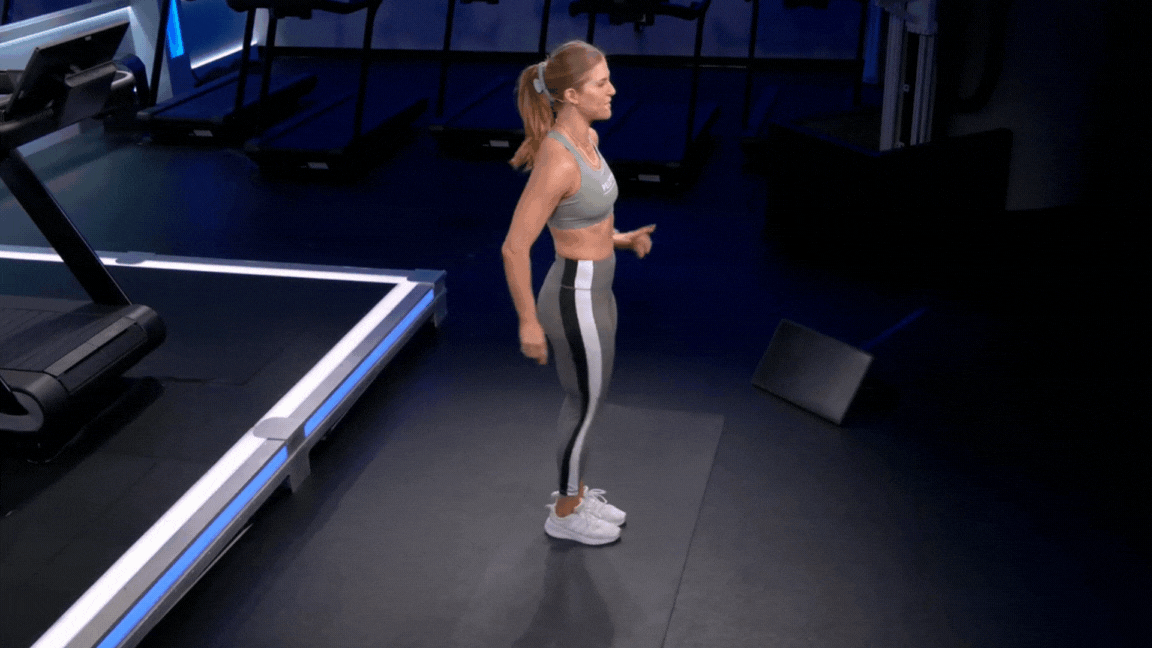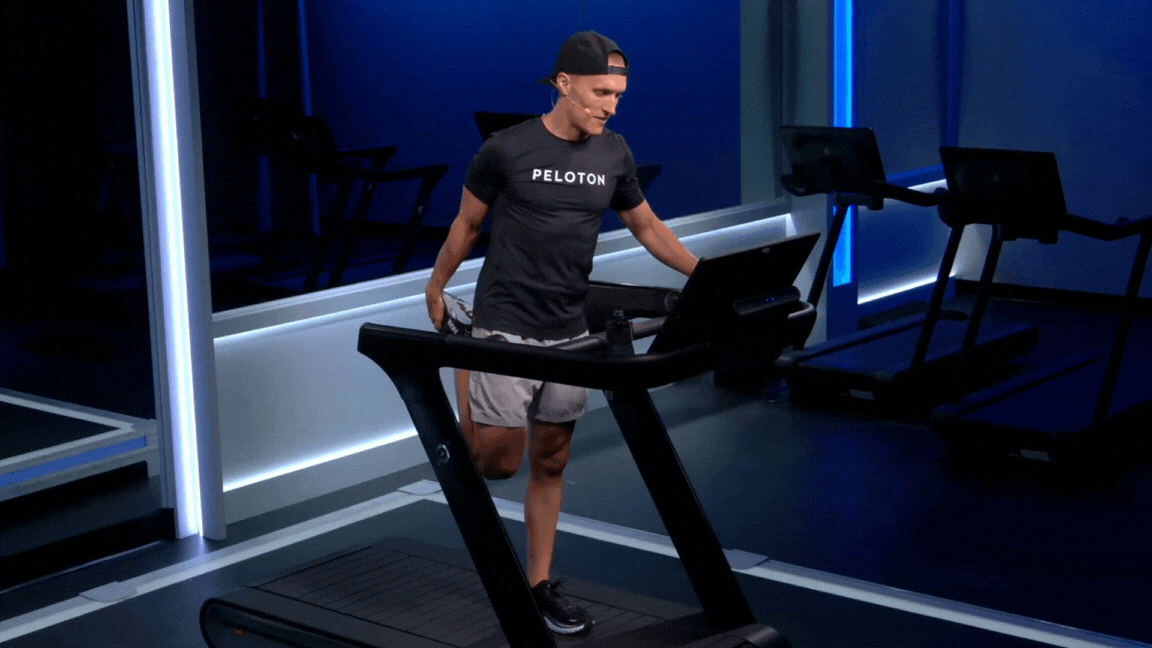
9 Essential Stretches Before Your Treadmill Running
Warming up properly makes a huge difference.
By Peloton•
Static stretching vs. dynamic stretching
Dynamic stretching, movement-based stretching
Why dynamic stretching?
What stretches to do before running on the treadmill
What to know about pre-running stretches
Don't neglect your post-run routine
Stretch Before You Run with Peloton
Stretching before a treadmill run is a crucial component of a solid, safe workout. Stretching prepares the muscles and joints for physical activity and helps to reduce the risk of injury, improve flexibility, and increase your range of motion.
Running stretches can help improve your performance and prepare your body for the demands of running on a treadmill. There are quite a few simple treadmill stretches that you can do to prepare your body and mind for your next run. We'll tell you all about them and how to execute them correctly!
Static stretching vs. dynamic stretching
Before jumping into a regular exercise routine, it's essential to know the difference between static and dynamic stretching. When you stretch your body statically, you'll hold the stretch for anywhere from 15 to 45 seconds, depending on what feels good for your body.
On the other hand, dynamic stretching involves controlled moves that will increase the range of motion of the muscle group that particular stretch targets. The goal of dynamic stretching is to warm your muscles through movement.
You can time your dynamic stretches by performing them for a certain amount of time, between 30 seconds and one minute, or you can count repetitions. Do whatever feels right for you, but keep in mind that dynamic stretching should improve your range of motion and flexibility with every successive repetition.
In short, the primary difference between static and dynamic stretching is that one requires gentle, controlled movement, and the other does not. If you're preparing for a treadmill run, dynamic stretching is definitely your friend!

Dynamic stretching, movement-based stretching
Whether you've had a solid workout routine for years or just started, it won't take long to notice that fitness instructors love dynamic stretching. Stretching through movement is the perfect way to stretch before any workout, but primarily those are high-intensity.
There's nothing wrong with static stretching; we love a good static stretch! However, movement-based stretching lets you warm up your body while you prepare it to move faster. Also, stretching while moving can be a fantastic way to relieve stress and get your mind in the right place before your workout.
Dynamic stretching isn't technically new, but in recent years we've seen many fitness instructors, influencers, and gurus recommend it over static stretching pre-workout. There are plenty of reasons we focus on movement-based stretching, even before a slow-flow yoga class, and here's why.
Why dynamic stretching?
It's hard to argue with a stretching modality that provides flexibility and a full-body warm-up in ten minutes or less, depending on which moves you choose. Dynamic stretching activates your core muscles, improving stability and challenging your muscles.
Dynamic stretching is undoubtedly athletic, but it's not reserved solely for athletes. While it improves sports performance, it also helps us thrive as we go about our daily activities. Please consider the following if we still haven't convinced you to ditch static moves as your pre-treadmill running stretches.
Flexibility Improvement
Inflexibility and muscle weakness go hand-in-hand, and they are two common causes of falls and sports-related injuries. Dynamic stretching strengthens the muscles around your joints, increasing their range of motion. We know we've mentioned it once or twice already, but flexibility is a must-have, and dynamic stretching can give it to you.
Better Performance
Because you're building more flexibility and a higher range of motion, dynamic stretching improves your activity performance overall. Regardless of your exercise goals, stretching dynamically improves acceleration, speed, and, most importantly, agility.
Higher Body Awareness
Dynamic stretching often mimics the movements that your fitness instructor has planned for your workout. For example, walking lunges could be a precursor to a reverse lunge with a bicep curl. Dynamic stretching can significantly reduce workout-related muscle soreness while assuring a more successful training session.
When it comes to treadmill stretches with a dynamic focus, you could perform jumping rope or side shuffles to get your feet and legs moving while focusing on agility. Dynamic stretching prepares you for the patterns and movements you'll use during your workout, which for running, are relatively straightforward.
What stretches to do before running on the treadmill
Front and Back Hurdles
Front and back hurdles will help open your hips and establish stability.
How to do it
Stand with your feet hip-width apart.
Lift your right leg, bending the knee at a 90-degree angle.
Open your right leg as far as possible to the right, as if you were jumping over a hurdle.
Bring your leg back to the center.
Repeat on the other side.

Leg Swings
Swinging your legs front and back will increase circulation and loosen your hips.
How to do it
Stand on one leg (you choose), and swing the other back and forth, slowly increasing your range of motion.
You can use the wall or a chair if you need balance assistance.
Switch sides.
Knee Hugs
Stretch your glutes, and lower back, and increase hip mobility with dynamic knee hugs!
How to do it
Stand with your feet hip-width apart.
Lift one knee to your chest, pulling your knee to your chest while holding your shin under your knee.
Hold the hug for one second, then repeat on the other side. Continue alternating legs.
Quad Stretch
A quad stretch, but make it dynamic! This juicy stretch will improve your balance and stability while activating your quads.
How to do it
Stand on your right leg and use your left hand to hold your left foot, pulling it towards your glutes.
Hold the stretch for one second, and repeat with your right leg.
Alternate legs.

Table Tops
Table Tops are perfect for strength and stability improvement and help loosen your glutes.
How to do it
Stand with your feet hip-width apart.
Lift one leg, keeping that knee bent at a 90-degree angle, and lift it to the side, similar to how a dog might visit his favorite fire hydrant.
Place your hand on your lifted knee and gently push it down, keeping your back straight and core tight.
Repeat on the other side, and remember you can do this on all fours if standing is too much.
Reverse Lunge with Rotation
This excellent dynamic stretch will loosen up your glutes, hip flexors, hamstrings, and quads.
How to do it
With your feet hip-width apart, step back with one foot and bend that same knee until your leg is at a 90-degree angle, with your knee almost touching the ground behind you.
Rotate your torso toward your front knee, come back to the center, and bring your back leg forward to the starting position.
Alternate.
Alternating Side Lunges
Increase mobility and loosen up adductors, glutes, hamstrings, and quads with some alternating side lunges!
How to do it
Stand with your legs wider than your shoulders.
Take a lateral step with your starting foot, bending your knee and sitting back, creating the side lunge.
Bring your foot back to the starting position and repeat with the other leg.
Toe Walks
Increase ankle mobility and strengthen your calf muscles with toe walks.
How to do it
Stand with your legs a hips-distance apart.
Come onto your tiptoes, and take small steps forward and backward. You can do these on the treadmill at a slow speed.
Single-Leg Deadlift
Activate your glutes, core, and hamstrings while working on that stability!
How to do it
Stand with your feet under your hips.
Lean forward, keeping your abs tight, and shift your weight onto your starting leg, extending that leg behind you for a T-shape.
Bring your extended leg back and repeat on the other side.
What to know about pre-running stretches
Stretching before a run using dynamic movements will reduce your risk of injury while getting you ready for your run. Spend at least ten minutes warming up off the treadmill, and when you get on, you can do exercises like toe walks and knee hugs at a very low speed.
Improving the quality of your workout is a critical aspect of dynamic stretching. When your body is warm, it can perform. Regardless of how long or short your run is, never skip the pre-run stretch!
Don't neglect your post-run routine
Just because you've stretched before your run doesn't mean you don't have to stretch after. Static stretches are perfect post-run as your muscles are warm and flexible, and they will help eliminate possible workout-related joint stiffness.
Static stretching after a run can decrease injury by improving flexibility. It might be tempting to hop off the tread and directly into the shower, but don't risk it. Stick to your post-run routine, even when you're short on time.
Stretch Before You Run with Peloton
Running a treadmill is fantastic for your physical and mental health, but it's important that you prep your body properly beforehand. Peloton has hundreds of online classes dedicated solely to stretching before and after your run on the tread.
You can't achieve your workout goals if you don't do everything possible to keep your body healthy, and stretching is a massive contributing factor to workout safety. Stretch it out with Peloton today!